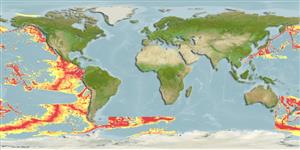Pallenopsis longiseta Turpaeva, 1957
| Native range | All suitable habitat | Point map | Year 2050 |

|
| This map was computer-generated and has not yet been reviewed. |
| Pallenopsis longiseta AquaMaps Data sources: GBIF OBIS |
Upload your photos
Google image |
No photo available for this species.No drawings available for Phoxichilidiidae.
Google image |
No photo available for this species.
Classification / Names Common names | Synonyms | CoL | ITIS | WoRMS
Pycnogonida | Pantopoda | Phoxichilidiidae
Environment: milieu / climate zone / depth range / distribution range Ecology
Benthic; depth range 1228 - 4100 m (Ref. 2157). Tropical
Distribution Countries | FAO areas | Ecosystems | Occurrences | Introductions
Antarctic Atlantic, Pacific and Arctic Oceans: Bering Sea.
Length at first maturity / Size / Weight / Age
Maturity: Lm ? range ? - ? cm
Short description Morphology
Trunk segmentation lines with distinctive mid-dorsal point directed anteriorly and not raised above curved surface of dorsum. Second scape segments not as long as first and leg tibiae bear long lateral setae as with Pallenopsis comosa. This species notably fewer sole spines than Pallenopsis comosa but it bears two long heel spines. Lateral processes with several short dorsal spines which are inconspicuous (Ref. 2157, p. 4).
Bathyal (Ref. 19).
Life cycle and mating behavior Maturity | Reproduction | Spawning | Eggs | Fecundity | Larvae
Members of the class Pycnogonida are gonochoric and sexually dimorphic. During copulation, male usually suspends itself beneath the female. Fertilization occurs as the eggs leave the female's ovigers. Males brood the egg masses until they hatch. Life cycle: Eggs hatch into protonymphon larva then to adults.
Main reference
References | Coordinator | Collaborators
Child, C.A. 1994. (Ref. 2157)
IUCN Red List Status (Ref. 130435)
CITES status (Ref. 108899)
Not Evaluated
CMS (Ref. 116361)
Not Evaluated
Threat to humans
Human uses
| FishSource |
Tools
More information
Internet sources
BHL | BOLD Systems | CISTI | DiscoverLife | FAO(Publication : search) | Fishipedia | GenBank (genome, nucleotide) | GloBI | Gomexsi | Google Books | Google Scholar | Google | PubMed | Tree of Life | Wikipedia (Go, Search) | Zoological Record
Estimates based on models
Preferred temperature
(Ref. 115969): 0 - 2.4, mean 2 (based on 1026 cells).
Price category
(Ref. 80766):
Unknown.


